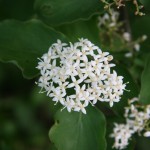Roughleaf Dogwood
Cornus drummondii
Cornaceae
Description
Roughleaf Dogwood is an unevenly shaped, cool-season shrub or small tree up to 20 ft or 6 m tall. It forms thickets from root suckers. Its young twigs are reddish brown and pubescent. It has simple, ovate leaves that are opposite each other. They are about 10 cm long by 5 cm wide and have three to five arching, elastic veins that hold together even after the leaf has been broken or pulled apart. The leaf veins are prominent on the lower surfaces. The leaves are rough on the upper surface (being covered with short, stiff hairs) and have an abruptly pointed tip. The leaves have a rounded base, smooth margins, and turn purplish red in the fall. From April to May, its cream-colored flowers emerge as many, broad, flat-top clusters from leaf axils. The flowers have four petals and four exerted stamens (longer than the pistil). The fruit, a tiny globular 1-2 seeded drupe, also emerges in rounded clusters and is small, waxy white, fleshy, and has a dark spot. It ripens from August to October. As the fruit ripens, the peduncle and pedicels become scarlet. The fruit is eaten by many species of birds. Roughleaf Dogwood serves as a good plant for sheltering wildlife and provides a high-calorie food source with its drupes. It has also been used for shelter-belt planting in the prairie-plains region.Habitat
Roughleaf Dogwood grows in moist soil in bottomlands and along creeks as well as in forests, thickets, and forest/prairie borders. It prefers partial sun and moist to dry conditions.Images
Plant Characteristics
Flower Color: White
Seed Type: Drupe, Fruit/Berry
Duration: Perennial
Stem Texture: Hairless/Smooth
Growth Habit: Shrub (Woody), Tree
Leaf Shape
 : Simple with Pinnate or Parallel Venation
: Simple with Pinnate or Parallel Venation
Season: Cool
Distribution
 : 01 - Pineywoods, 02 - Gulf Prairies and Marshes, 03 - Post Oak Savannah, 04 - Blackland Prairies, 05 - Cross Timbers and Prairies, 06 - South Texas Plains, 07 - Edwards Plateau, 08 - Rolling Plains
: 01 - Pineywoods, 02 - Gulf Prairies and Marshes, 03 - Post Oak Savannah, 04 - Blackland Prairies, 05 - Cross Timbers and Prairies, 06 - South Texas Plains, 07 - Edwards Plateau, 08 - Rolling Plains
Distributions
Distribution refers to the ecological region in Texas that a plant has been found. You can also view a clickable map.
Collection: Brush and Weeds






